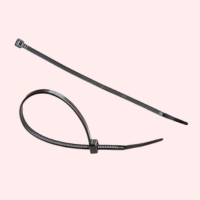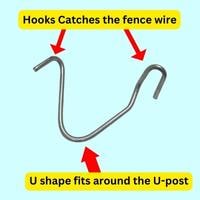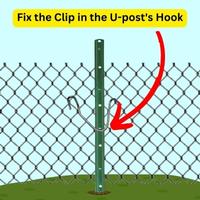Fence post clips & zip ties are widely used to attach a wire fence to the U-posts. However, if you’ve got nothing, simply use pieces of metal wires. In my area, there are a lot of spare telephone drop wires hanging on the poles, so anyone can use them. I’ve also used pieces of telephone drop wires to tie the garden wire fence to the metal posts. Similarly, you can use any available sturdy wire or rope for attachment.
Fence clips are specially designed in a U/V shape to attach wire fences to metal posts, i.e., U-posts or T-posts. Also, they are sturdy, inexpensive, and easy to install & remove. Zip ties also offer years of service at a very low price. While metal wires are commonly available in homes.
In this post, we’ll discuss all the tools & methods to install wire fences with u posts.
How to Attach a Wire Fence to U-posts?
Starting from a corner post, unroll the wire fence toward the other posts. Then, vertically align the fence on the studded side of the U-posts. Now start tying the fence from the corner post, from the top toward the bottom. Keep the fence stretched from top to bottom & make sure it touches the ground. Also, stretch the fence horizontally while continuing toward the next post. Similarly, attach the fence to all U-posts.
The following tools can be used to attach wire fences to U-posts:
Tool 1: If you don’t have fence post clips or zip ties, take 6 to 8-inch pieces of thick metal wire. At the desired height, wrap the piece of wire around the U-post & hook it in the nearest U-post stud. Now, wrap the closest vertical wire of the wire fence into the piece of wire. At last, twist both ends of the piece of wire with a plier & trim the excess for safety.
Tool 2: Simply wrap the zip tie around the U-post & hook it into a stud(hook) at the desired height. Then, catch the closest horizontal wire or diagonal joint of the wire fence and tighten the zip tie.
Tool 3: Get fence post clips. Wrap them around the U-post and hook them into the nearest stud. Now, catch the closest horizontal wire of the wire fence in both ends/hooks of the post clip. Use a clip bender or plier to twist the ends of post clips around the fence wire.
Note: Fence clips are useful for attaching heavy gauge wire fences to metal posts because thin wire fences, i.e., chicken wire, may break while twisting the hooks of the clips.
How many joints you should join the wire fence to the U-posts? Use at least 3-5 post clips/ zip ties or pieces of metal wire on each U-post at an even distance(1-1.5 feet).
Below, we’ll describe each tool & step to attach wire fences to U-posts in detail:
Unroll the fence along the U-posts:
Unroll the roll of the wire fence along the studded side of the T-posts. It’s because the T-post studs are used to hold fences are other fencing materials. Now vertically align the wire fence. Make sure the fence is stretched from top to bottom. Temporarily hook the fence to the U-posts so that it stays straight while attaching to the posts. Make sure the fence is stretched from top to bottom & is touching the ground so that no animals can intrude in or escape. Tye the fence from top to bottom at regular intervals of 1-1.5 feet depending on the desired strength.
After attaching the fence to the first post, slightly stretch it with your hands. When using U-posts it’s not recommended to over-stretch the fence as it may exert enormous pressure(tension) on the posts resulting in bending.
Here are some tools that I’ve used multiple times for attaching wire fences to T-posts & U-posts.
Tool 1: Metal Wire
It’s the most cost-effective method I apply the most in my DIY projects & would also suggest you. Metal wire or pieces are commonly available at home junk stores. Or you can buy a 50 or 100-foot roll of metal wire for around 10 $ & it would be more than enough for a large project.
Choose slightly thick metal wire depending on the strength you want. An 18-20 gauge metal wire would provide enough strength for lightweight to heavy-duty fences.
Simply cut off 6-inch pieces of metal wire, diagonally or horizontally & wrap the piece of wire around the U-post & the closest horizontal wire or joint of the wire fence. Twist the ends of the piece of wire with a plier & bend them inwards so they don’t hurt anyone.
Tool 2: Zip Tie:
Heavy-duty zip ties such as .3 inch wide & 12 inch long are also ideal for attaching wire fences to U-posts. Zip ties are lightweight, cheap & quite strong ideal for lightweight wire fences. They can serve you for at least a year, depending on the exposure to sunlight, the weight of the fence, or the expected load on the fence. That’s why you should invest in heaty-duty UV-resistant zip ties.
As zip ties are made of plastic, they are less reliable than metal clips or wires in terms of durability. So you should use zip ties only when installing temporary or short area or lightweight wire fencing, i.e., around the garden, keeping small-sized or fewer animals.
If your fence has to withstand a lot of weight(animal load), you shouldn’t use zip ties for attaching wire fences to U-post.
Tool 3: Fence Post Clips:
Fence post clips are specially designed to professionally attach wire fences to U-posts, T-posts & other metal posts. They are made of metal, probably steel, forged into a V or U shape that fits around the post, while the hooks at both ends catch the fence wire. Post clips give a smooth joint and a nicer look to your fence. They are easy to install as well as easy to remove & can be used later. However, remember that post clips should only be used with heavy-duty(thick gauge) wire fences.
Follow the Step-by-Step guide to install wire fence to U-posts using fence clips.
Step 1: Choose the right fence post clips
Choose post clips made of galvanized steel to prevent corrosion. Remember, U-posts and fence post clips are available in different sizes. So, choose fence clips according to the diameter of your posts.
Also, fence clips are available in V, U, or round shapes. Hence, choose them according to the shape of your fence post. A bag of 100 fence clips usually costs around 15$.
Step 2: Align the fence with a U-post & put post clips on
After installing U-posts, vertically align the welded wire fence on the studded side of the posts.
Place the fence post clip around the U-post. Fix the clip under the U-posts hook(stud).
A U-post has hooks/studs & holes that help to hold the fencing material i.e. fence or post clips in place. Also, these hooks will keep the fence post insulators in place during electric fence installation.
Step 3: Lock the wire in the fence and the post clip’s hooks
After you’ve hooked the post clips under the U-post studs(hook), push the closest upper wire downward and fix it between both hooks of the fence post clip.
Step 4: Bend the clip’s hooks around the fence wire:
After you’ve placed the fence clips around the U-posts and locked the upper fence wire in the hooks, the only thing left is to twist the clip’s end around the fence wire.
For this purpose, you can use a clip bender tool, a plier, or a plass.

What is a clip bender tool & how to use it?
A fence post clip bender tool is specially designed to bend/twist the hooks of post clips around the wire fence. It is a simple tool with two metal pieces connected like an arm & works on the base of Lever Physics. One metal piece has holes to catch the fence clip’s end. The handle is rotated around the fence wire. Clip bender tools have different-sized holes to work with fence clips of different gauges.
Steps to use a clip bender tool:
After placing clips around the post & locking the fence wire, insert the clip’s end in the hole of the clip bender tool.
Then lock the arm(joint) of the clip bender tool & rotate the tool around the fence wire, and the clip will bend and twist around the fence wire.
A single twist would be enough if you temporarily install a wire fence. However, if you are installing a long-term(permanent) fence, keeping large livestock or a large number of animals, twist the fence clip’s hooks entirely around the fence wire so that the joint never unties due to the animal’s load.
Once fence clips are installed, ensure they are tight and secure.
Conclusion
As per my experience, fence post clips are ideal for professional work, and they have a nice look & a smoother finish as they are quite sturdy, inexpensive, and easy to install & remove for reuse.
However, zip ties are a great alternative to fence clips & ideal for installing less-weight wire fences, such as in short areas or around the garden or keeping small animals.
Pieces of wires are also a perfect option if you don’t want to invest in any tool. If you still need any assistance, ask us in the comments below.
Related Guides:

